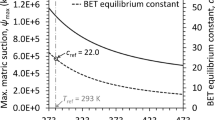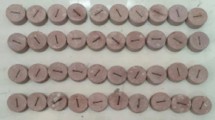Abstract
Moisture content changes during drying were investigated in the present work. Particular emphasis was placed on the initial stage of drying of saturated concrete, where moisture contents are high. For this stage of drying, experimental data are lacking, and no comprehensive theory exists to describe it.
The present investigation was performed experimentally and numerically for drying of cylinders with one exposed end, made of normal weight and lightweight concrete with varying water to cement ratio (w/c). The gravimetric technique was employed to obtain the spatial distribution of moisture content. The experimental results obtained indicate that drying of concrete becomes diffusion controlled when the average moisture content decreases below 70 to 80% of the initial saturation. Typical drying rates are in the order of magnitude of 0.18 kg/day/m2 and 0.02 kg/day/m2 for the first and the second stage of drying, respectively.
The lightweight concrete cylinders as compared to those made of normal weight concrete exhibited higher levels of moisture content throughout the process. At high w/c ratios, the moisture profiles for both types of cylinders, as expected, show steeper changes with time. Large, constant drying rates were observed both experimentally and numerically in the beginning of the drying.
The numerical model developed is based on a generalized mathematical formulation for mass and heat transfer in porous media, and its predictions are in agreement with the experimental data within the uncertainty range of the input data.
Similar content being viewed by others
Abbreviations
- D :
-
diffusion coefficient, m2/s
- DR:
-
drying rate, kg/(m2s)
- (c p ):
-
specific heat, J/(kg K)
- f att :
-
attenuation factor
- g :
-
acceleration of gravity, m/s2
- h s :
-
differential heat of sorption, J/kg
- Δh vap :
-
heat of evaporation, J/kg
- K :
-
specific permeability, m2
- k i :
-
relative permeability of i phase
- M i :
-
molecular weight, kg/mole
- \(\overline {m_i }\) :
-
mass evaporation rate of i phase, kg/(m3s)
- n boun :
-
unit vector normal to the boundary surface
- n grav :
-
unit vector acting in the direction of gravity acceleration
- p :
-
pressure, Pa
- R :
-
universal gas constant
- r :
-
pore diameter, m
- S :
-
saturation
- S d :
-
surface, m2
- T :
-
temperature, K
- t :
-
time, s
- Δt :
-
time step, s
- u :
-
x component of the velocity vector, m/s
- V :
-
volume, m3
- v :
-
velocity vector
- v :
-
y component of the velocity vector, m/s
- W :
-
weight of a disc, kg
- w :
-
moisture content (mass of water / unit volume of concrete), kg/m3
- x,y :
-
Cartesian coordinates, m
- α :
-
heat transfer coefficient, W/(m2K)
- β :
-
mass transfer coefficient, m/s
- ɛ i :
-
volumetric fraction of phase i
- φ :
-
arbitrary quantity
- λ eff :
-
effective thermal conductivity, W/(mK)
- μ :
-
viscosity, kg/(ms)
- ξ :
-
underrelaxation factor
- ϱ :
-
density, kg/m3
- σ t :
-
surface tension, N/m
- ψ e :
-
global energy residual, J
- ψ m :
-
global mass residual, kg
- O:
-
initial
- 1:
-
water vapour
- 2:
-
air
- atm:
-
atmospheric
- att:
-
attenuation
- b :
-
bound water phase
- boun:
-
boundary
- c :
-
capillary
- d :
-
drying
- dry:
-
dry state
- e :
-
energy
- eff:
-
effective
- g :
-
gaseous phase
- grav:
-
gravitational
- irr:
-
irreducible
- l :
-
liquid water phase
- m :
-
mass
- ref:
-
reference
- s :
-
solid phase
- wet:
-
wet state
- ∞:
-
ambient
- g :
-
intrinsic average over volume of gaseous phase
- (i):
-
current iteration level
- l :
-
intrinsic average over volume of liquid phase
- (n):
-
time level at time (t)
- (n + 1):
-
time level at time (t + Δt)
- sat:
-
saturated
- -:
-
averaged quantity over a REV
- -i :
-
intrinsic average over phase i of a REV
- /:
-
normalized
References
Bazant, Z. P. and Najjar, L. J.: 1972, Nonlinear water diffusion in nonsaturated concrete, Materials & Structures 5(25), 3–20.
Bazant, Z. P.: 1985, Constitutive equation of wood at variable humidity and temperature, Wood Sci. Technol. 19, 159–177.
Bazant, Z. P. and Kim, J.: 1991, Consequences of diffusion theory for shrinkage of concrete, Materials & Structures 24, 323–326.
Becker, R. and Katz, A.: 1990, Effect of moisture movement on tested thermal conductivity of moist materials, ASCE J. Materials Civil Engg. 2, 72–83.
Daian, J. F.: 1988, Condensation and isothermal water transfer in cement mortar: Part I - pore size distribution, equilibrium water condensation and imbibition, Transport in Porous Media 3, 563–589.
Dhir, R. K., Hewlett, P. C. and Chan, Y. N.: 1989, Near surface characteristics of concrete: intrinsic permeability, Magazine of Concrete Res. 41(147), 87–97.
Galloway, J. W., Harding, H. M. and Raithby, K. D.: 1979, Effects of moisture changes on flexural and fatigue strength of concrete, Transport and Road Research Laboratories, Report 864, U.K.
Hanson, J. A.: 1968, Effect of curing and drying environments on splitting tensile strength of concrete, ACI J. 65, 535–543.
Hashida, H., Tanaka, K. and Koike, M.: 1990, Moisture distribution in concrete before and after application of the finish, Building Res. Practice 5, 303–308.
Larbi, J. A.: 1993, Microstructure of the interfacial zone around aggregate particles in concrete, Heron 38(1).
Masmoudi, W. and Prat, M.: 1991, Heat and mass transfer between a porous medium and a parallel external flow. Application to drying of capillary porous materials, Int. J. Heat Mass Transfer 34, 1975–1989.
McCabe, W. L. and Smith, J. C.: 1976, Unit Operations of Chemical Engineering, McGraw-Hill, New York.
Mehta, P. K.: 1986, Concrete: Structure, Properties and Materials, Prentice Hall, Englewood Cliffs, NJ.
Ooi, O. S.: 1988, Aggregate saturation in lightweight concrete, MSc Thesis, University of New Brunswick, Fredericton, Canada.
Parrott, L.J.: 1991, Factors influencing relative humidity in concrete, Magazine of Concrete Res. 43(154), 45–52.
Patankar, S. V.: 1980, Numerical Heat Transfer and Fluid Flow, Hemisphere Publ., New York.
Penev, D. and Kawamura, M.: 1991, Moisture diffusion in soil-cement mixtures and compacted lean concrete, Cement Concrete Res. 21, 37–146.
Perre, P. and Degiovanni, A.: 1990, Simulation par volumes finis des transférts couplés en milieux poreux anisotropes: séchage du bois a basse et a haute temperature, Int. J. Heat Mass Transfer 33, 2463–2478.
Roy, D. M. and Idorn, G. M.: 1993, Concrete Microstructure, Stategic Highway Reasearch Program, Report No. SHRP-C-340, National Research Council, Washington, DC.
Sakata, K.: 1983, A study on moisture diffusion in drying and drying shrinkage of concrete, Cement Concrete Res. 13, 216–224.
Scheidegger, A. E.: 1974, The Physics of Flow Through Porous Media, University of Toronto Press, Toronto, Canada.
Šelih, J.: 1994, Movement of water during drying of fully saturated concrete, PhD thesis, University of New Brunswick, Canada.
Šelih, J., Sousa, A. C. M. and Bremner, T. W.: 1994, Moisture and heat flow in concrete walls exposed to fire, ASCE J. Engg. Mech. 120(10), 2028–2043.
Skaar, C. and Siau, J. F.: 1981, Thermal diffusion of bound water in wood, Wood Sci. Technol. 15, 105–112.
Sugiyama, T.: 1994, Permeability of stressed concrete, Ph.D. Thesis, University of New Brunswick, Fredericton, Canada.
Volkwein, A.: 1991, Untersuchungen uber das Eindringen von Wasser und Chlorid in Beton, Dokt. Dissertation, Technische Universität München, Munich, Germany.
Whitaker, S.: 1977, Simultaneous heat, mass, and momentum transfer in porous media: a theory of drying, Adv. in Heat Transfer 13, 119–200.
Zhang, M. H. and Gjorv, O. E.: 1990, Microstructure of the interfacial zone between lightweight aggregate and cement paste, Cement Concrete Res. 20, 610–618.
Author information
Authors and Affiliations
Rights and permissions
About this article
Cite this article
Šelih, J., Sousa, A.C.M. & Bremner, T.W. Moisture transport in initially fully saturated concrete during drying. Transp Porous Med 24, 81–106 (1996). https://doi.org/10.1007/BF00175604
Received:
Revised:
Issue Date:
DOI: https://doi.org/10.1007/BF00175604




